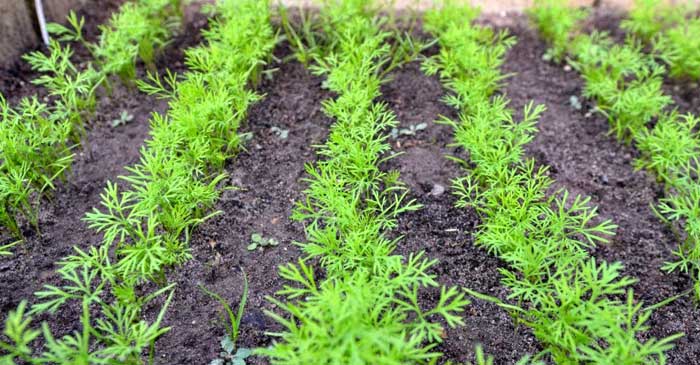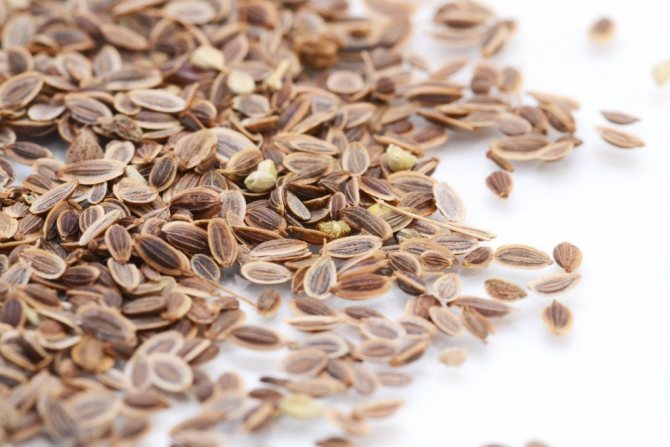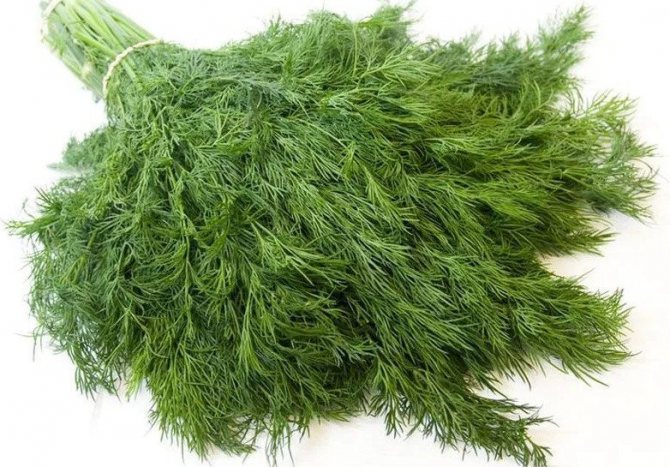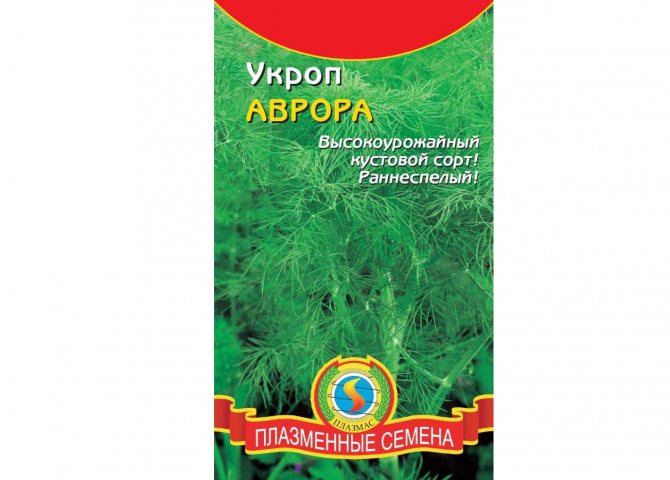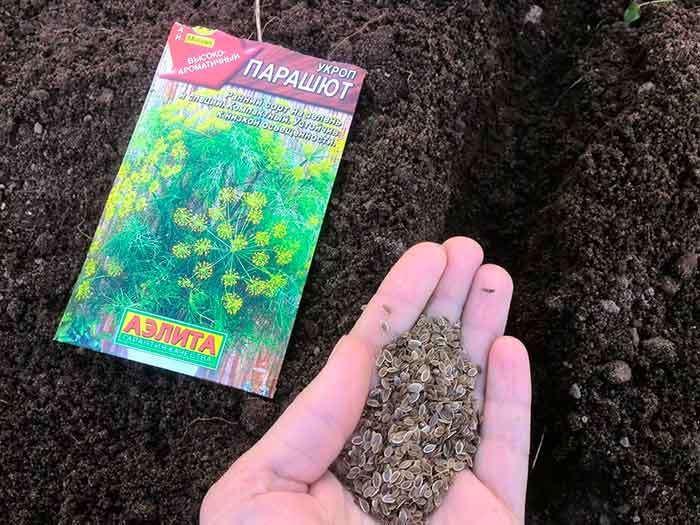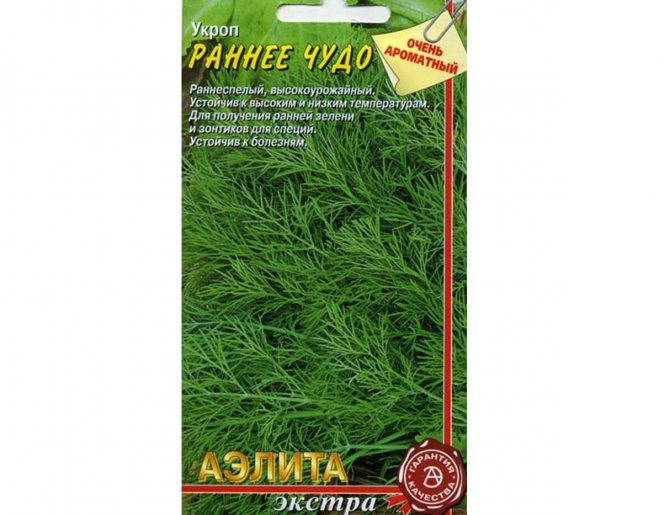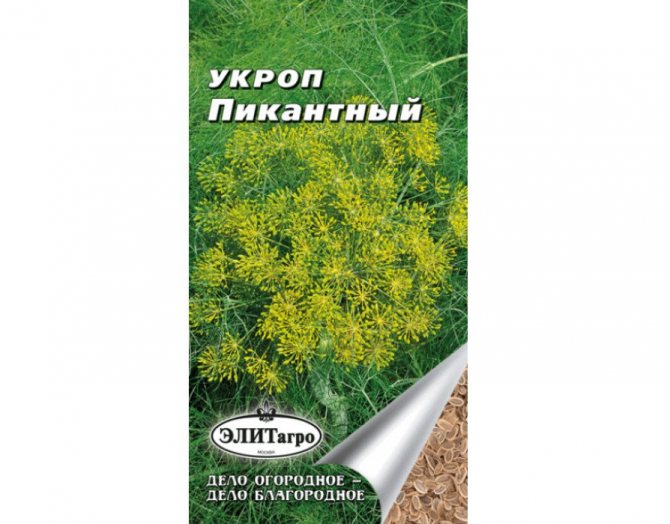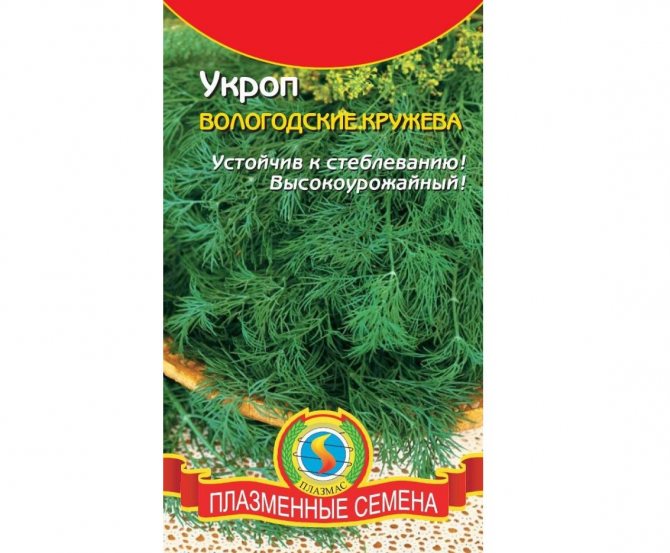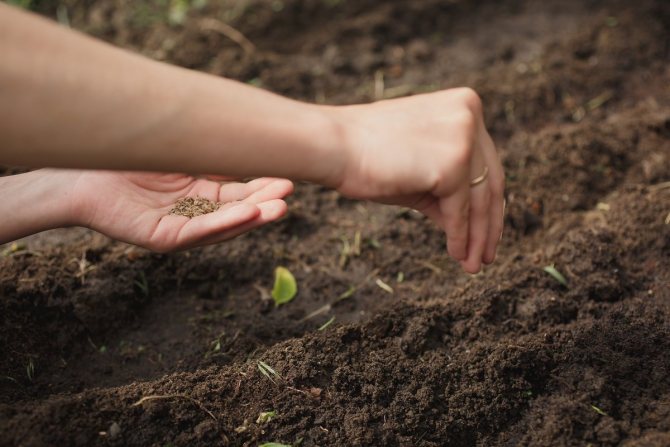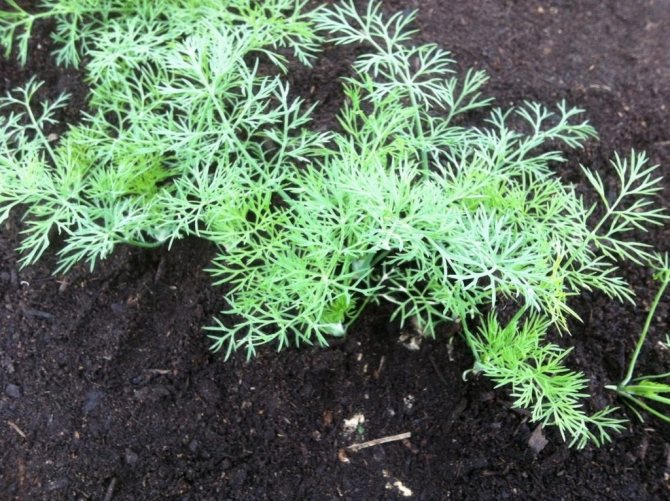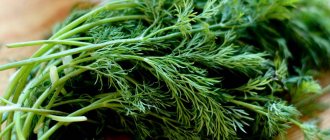Everyone knows the aromatic taste of dill. Growing this plant will not be difficult even for a novice gardener. This crop is resistant to cold weather and does not suffer from a lack of water, it is even able to withstand a slight drought. Growth is not hampered by a lot of shading, the best growth occurs in soils rich in organic matter. Everyone knows the traditional method of planting in the spring, but in this article we will look at how dill is planted before winter.

Fresh dill
What varieties of dill can be sown in the fall
There are three types of dill:
- Normal. The plant has a single stem with numerous leaves. An umbrella with seeds is formed at the top.
- Bush. At the base of the main stem, 5-6 internodes are formed, from which lateral stems develop.
- Densely leafy. The plant has one stem, but due to the large number of leaves, such dill resembles a small Christmas tree.
In these three categories, breeders have bred a great variety of varieties and hybrids with different ripening times and distinctive features. Dill of any varieties is planted before winter, but for best results, you should give preference to varieties with increased frost resistance, early and medium ripening periods:
- Kharkiv 85;
- Atlant;
- Ambrosia:
- Shmaragd;
- Umbrella;
- Gribovsky:
- Vologda lace;
- Grenadier.
In the listed varieties, fresh herbs are harvested 30-45 days after germination.


Sowing rules
It is worth adhering to a number of rules when preparing the soil and when choosing a planting site.
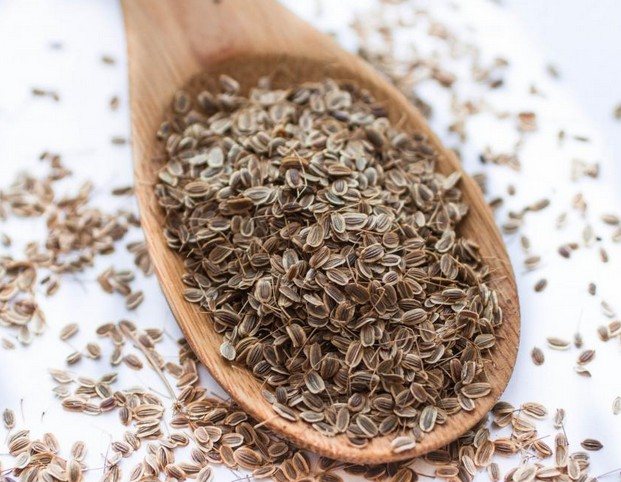

Choosing a landing site
It is preferable to grow the crop on loose nutrient soils. Heavy clayey soils have a bad effect on seed germination and the quality of greenery. Planting on wet and acidic soils is not recommended.
The place should be well lit and ventilated. With a lack of sun, the dill will germinate later and will be prone to stretching.
The best predecessors for him are cucumbers, carrots or cabbage. Unsuccessful predecessors in crop rotation are similar aromatic crops.
Fertilization
Dill is also undemanding to soil nutrition. It is possible to introduce organic or mineral fertilizing both during the preparation of the beds and in the spring.
For the full development of culture, it is necessary:
- phosphorus - up to 30 g per m2 of the garden as part of a complex fertilizer;
- potassium - up to 10 g of potassium salt per m2;
- humus - 3-5 kg / m2.
It is important not to overfeed the plants with nitrogen: roots, grasses and many crops cannot tolerate excess nitrogen. The hero of our story is not at all demanding. But the culture is very responsive to the mineral complex with an emphasis on potassium, phosphorus plus trace elements.
Selection of variety and preparation of seed preparation of seeds
Dill is planted before winter for early greenery, but given its exactingness to the length of daylight hours, medium-early, medium and late varieties are chosen for winter planting.
To do this, it is better to choose several varieties of different ripening periods:
- early;
- medium;
- late.
From late bush late varieties - Alligator, Dukat, Buyan, Late varieties - Kibray, Anna, Borey, medium ripening - Salut, Khanak, Amazon, Umbrella, early - Gribovsky, Dalny, Grenadier, Redut.
Such selection will allow to obtain high quality sheet products without interruption and for a long time.
In the fall, it is not required to carry out pre-sowing processing of the material, soaking in water or stimulants: this will cause its rapid germination.
How to choose the time for autumn planting before winter and when to prepare the beds
The timing of autumn sowing of dill depends on the climate of the region and the weather conditions of the current period. If the fall is too warm and the seeds are planted early, the seeds may germinate. The optimal sowing time is considered to be the days when the daytime air temperature is set within 0-3 ° C:
- in the Moscow region: in November;
- in Siberia and the Urals: in the middle - end of October;
- in the south: in the second half of November - early December.
If for spring sowing the beds and the soil on them are prepared in the fall, then for winter dill the planting site is prepared in the summer, in mid-July - early August.
Preparing the beds
Dill needs open and brightly lit areas with fertile, loose soil. In such beds, the plants become lush, fragrant and have strong stems. When preparing the beds for planting, you need to dig deep into the ground, crushing all the lumps, and then add organic fertilizing (humus or compost). After fertilizing the soil, the surface of the garden is leveled.
It is better to place seed holes in the open field in the direction from north to south so that the rows of the crop are evenly illuminated and warmed up. The distance between the rows of dill should be about 20 cm for the free formation and development of the root system. Before the onset of the first frost, the soil subsides slightly, and the bed becomes ready for planting.
Advantages and disadvantages of autumn planting
Planting dill in the fall before winter has many advantages:
- seeds will sprout 10-15 days earlier than spring crops;
- there is no risk of seeds freezing;
- strong and friendly shoots;
- plants will have strong immunity to diseases and adverse factors;
- saving time for other work in the spring;
- the ability to collect several harvests of greens per season.
There were no significant drawbacks to the method. There are certain risks that many gardeners attribute to disadvantages:
- in case of unstable weather (sudden thaw in autumn), inaccurate forecasts, there is a risk of untimely germination of seeds;
- increased seed consumption (more by 20-30%);
- the probability of seedling death in spring during return frosts.
How to properly plant dill in the fall before winter
Winter sowing is somewhat different from the traditional spring sowing. Knowing the secrets and subtleties of autumn planting, you can avoid many problems, because of which summer residents often refuse this method of growing.
Seat selection
Dill prefers places well lit by the sun throughout the day (the minimum duration of bright lighting is 12 hours), and rich in organic matter, light and neutral in acidity.... It is difficult to grow lush emerald greens on acidic and poor soil. Such lands are cultivated in advance.
When choosing a place for dill, it is important to observe the crop rotation. The best predecessors for him are cucumbers, early potatoes, tomatoes, radishes, white cabbage and cauliflower. You can not sow dill after plants of its own Umbrella family: cilantro, carrots, caraway seeds and fennel.
Important! A bed, brightly lit by the sun for a long time, is a must for winter dill. Snow will melt on it faster than other places, the soil will warm up and seedlings will appear.
Seed preparation
Seeds are sown dry before winter. Pre-treatment, soaking and other pre-sowing procedures are not required. The seeds must be fresh: if they are harvested from their own garden, then they must be this year.
Garden bed preparation
Before you start preparing the soil for cultivation, it is important to know exactly which soil, in terms of nutritional value and texture, prevails in the garden. To determine this in the field, there is such a test. Take a handful of earth and make a fist.
If a lump of soil, when pressed on it, easily falls apart into grains, you have sandy loam soil in front of you. Soils with a high clay content are slippery and greasy to the touch. You can easily roll a sausage out of it.
Weeds growing on it speak about the acidity of the soil. Indicators of very acidic soils are:
- field navel (one of the wild types of chamomile);
- blueberries;
- heather;
- sorrel;
- horsetail.
Having determined the type of soil and its acidity, two weeks before sowing, proceed to the following activities:
- The soil is dug onto the bayonet of the shovel to remove the weed rhizomes.
- At the same time it is limed (2-3 kg of lime for every 10 sq. M.) And a complex of fertilizers (rotted manure, sifted wood ash, superphosphate and potassium chloride) is applied - 20-30 g per 1 sq. M. m.
- With a rake, they level the soil well, breaking all lumps.
Attention! Manure or compost applied to the soil must be completely rotted, otherwise weed shoots will clog the seedlings.
Sowing pattern and depth


Dry seeds are sown into the soil according to the following scheme:
- embedment depth - 3 cm;
- the distance between the rows is 10-15 cm;
- the distance between plants is 0.51 cm.
Other rules
Such a deep seeding depth is not accidental. It is desirable that 1.5 cm is fertile soil, and the other 1.5 cm is a mulching warm layer. Peat, dry manure crumbs, sawdust of deciduous trees are used as mulch for dill. Mulch not only retains heat and protects against frost, but also prevents the formation of soil crust after the snow melts.
We prepared a bed, but did not have time to sow - did it snow? No problem! You can sow in December, at the first thaw. Spread lightly 2-3 cm of snow, sow seeds directly over the snow cover and cover with a layer of snow.
Preparing the beds
In order for the dill sown in autumn to give amicable shoots and please with a good harvest, several conditions must be observed:
- For the garden, a sunny or slightly shaded area with light soil is chosen. The plant does not like shade and high soil moisture.
- The place where tomatoes, legumes, cabbage used to grow is perfect for him. Dill does not tolerate neighborhoods with carrots and celery. Do not place it next to fennel, in this case the plants are pollinated, and the taste of each of them changes greatly.
- Organic fertilizers are applied to the open ground at the rate of 5 kilograms per square meter of area, and dug up.
- The plant prefers neutral soils. On alkaline soils, greens acquire a reddish tint, on acidic soils they turn yellow.
How to care for dill planted in the fall before winter
Unpretentious dill does not require large-scale maintenance. For a bountiful harvest, seeds need to be properly winterized so that they do not rot and freeze. The choice of mulching and covering material depends on the winter temperatures of the region and the level of groundwater at the site.
The best material suitable for covering crops in any region is agrofibre, and on top of it is peat mulch.
In the spring, when seedlings appear, caring for the crop includes the following mandatory agricultural practices:
- Regular watering. It is important not to allow the topsoil to dry out. Frequency of watering - 1 time per day, on hot days - 2-3 times.
- Root dressing. Organic matter is used as fertilizer - bird droppings or manure. For lush greenery, 1-2 dressings are enough for the entire growing season of the plant.
- Weed vegetation weeding. Weeds are the worst enemies of any green culture. Capable of active growth, they take away the necessary space under the sun and nutrients from the soil from cultivated plants.
- Shelter on hot days from direct sunlight. Young seedlings of dill are very tender. If the weather is abnormally hot in spring, canopies of gauze or thin white lutrasil are erected over the beds.
- Protection from pests is possible only with the help of folk methods of struggle. To scare off harmful insects, sprinkle herbs with tobacco dust or dry garlic powder mixed with sand in a 1: 1 ratio.
Harvesting and storage
Depending on the variety chosen, it takes 25 to 50 days to grow fresh winter greens. Cutting dill starts from a height of 7 cm. If greens are grown for sale, they wait for a height of 20-25 cm. The crop is harvested all at once or as needed.
The collected greens are used for food and stored in the refrigerator for a short time. For long-term storage, dill is dried or frozen. For freezing, greens are washed from dirt and finely chopped. It is convenient to freeze the spice in ice trays to add portioned cubes to various dishes.
Seed planting scheme: on an umbrella or on greens
An important difference from spring planting is the seeding pattern and depth. The seed is buried in the fall by 3-3.5 cm, i.e. 1-1.5 cm deeper to prevent freezing.
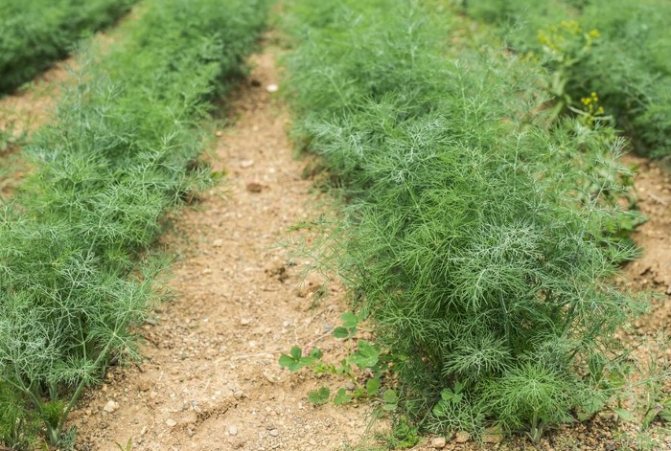

It is recommended to mulch the bed in order to avoid the formation of a crust on the soil surface and rotting of the seed.
Seed consumption rates for seeding in autumn are increased by at least a quarter to compensate for damage to seed in winter.
The planting scheme depends on the variety: on the diameter of the outlet, power and height, on the percentage of germination. The principle is the same: the more powerful and higher the bush, the greater the distance between the rows when sowing.
The following landing schemes are used:
- fan-shaped method - dill is scattered over the garden bed “in a fan”, without observing the rows;
- belt method (two-, three, four-row) - sowing in rows, the distance between which varies depending on the purpose of cultivation: for greens - from 20 to 25-30 cm, for an umbrella - from 30 cm and above.
- on large-scale areas, a two-line seeding scheme is used 12 + 58, 20 + 60, 25 + 70, a wide-row method with a row spacing of 45 cm.
With the fan method, with a thickened carpet planting, the consumption of dill seeds is about 1-1.5 g / m2. With the tape method - up to 1 g m / 2.

